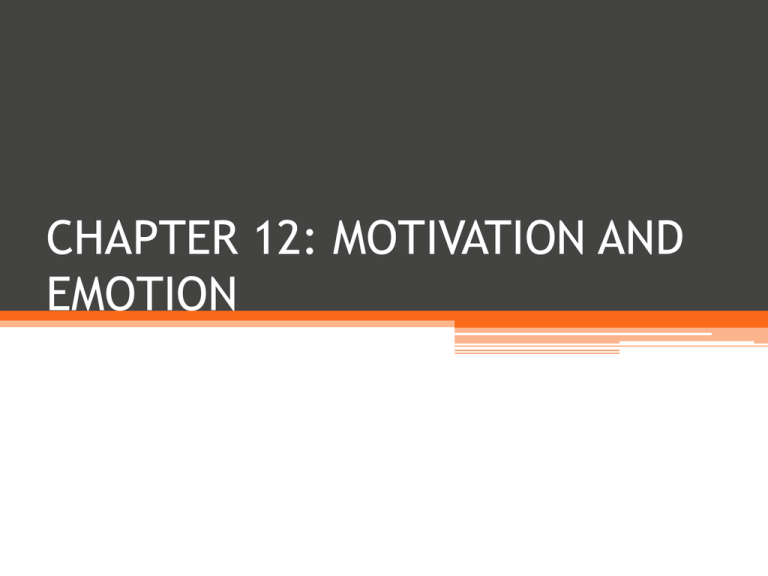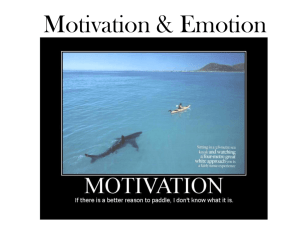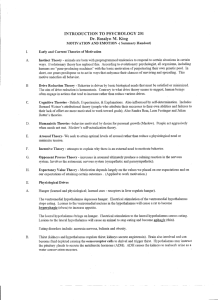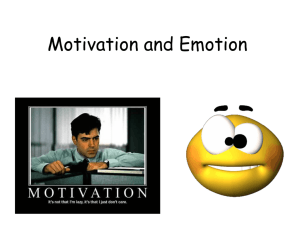CHAPTER 12: MOTIVATION AND EMOTION
advertisement

CHAPTER 12: MOTIVATION AND EMOTION MOTIVATION • Def: an internal state that activates behavior and directs it toward a goal • Not readily observable • Can be intrinsic, extrinsic, or both INSTINCT THEORY • Proposed by William McDougall (1908) • Instincts: innate tendencies that determine behavior • William James: human instincts include cleanliness, curiosity, parental love, sociability, and sympathy • Do not explain behavior, they label it DRIVE-REDUCTION THEORY • Motivation starts with a Need: biological or physiological requirement of an organism • Need produces a Drive: state of tension produced by a need that motivates an organism toward a goal D-R CONTINUED • Clark Hull • Organisms are driven by Homeostasis: the tendency of all organisms to correct imbalances and deviations from their normal state • Says all drives extend from biological needs • Overlooks fact that some experiences are inherently pleasurable INCENTIVE THEORY • Incentive: an external stimulus, reinforcer, or reward that motivates behavior • Drives push toward a goal, incentives pull COGNITIVE THEORY • Extrinsic motivation: engaging in activities that either reduce biological needs or help us obtain external incentives • Intrinsic motivation: engaging in activities b/c they are personally rewarding or b/c they fulfill our beliefs or expectations • Overjustification effect: intrinsic motivation declines when extrinsic motivation is used too much HUNGER • Lateral hypothalamus (LH): part of the hypothalamus that produces hunger signals • Ventromedial hypothalamus (VMH): part of the hypothalamus that can cause one to stop eating GLUCOSTATIC THEORY AND SET-POINT • Hypothalamus monitors glucose in blood • Low levels activate LH, pancreas releases insulin • Set-point: the weight around which your day-to-day weight fluctuates PSYCHOLOGICAL FACTORS OF HUNGER • External cues • Sight, smell, social pressures, boredom, stress OBESITY • Obese: 30% or more above your ideal weight • Overweight: 20% • 31.8% of all Americans are obese • Obese tend to eat more based on external cues ACHIEVEMENT MOTIVE • The desire to set challenging goals and persist in reaching those goals despite obstacles, frustrations, or setbacks • McClelland’s Thematic Apperception Test (TAT) • High achievers: less need for intimacy; prefer to associate with experts who will help them achieve FEAR OF FAILURE • Choose to take easy tasks or impossible tasks w/no chance of success • Make excuses • All to maintain a positive selfimage FEAR OF SUCCESS • Martina Horner • Found fear of success was greatest in women with above average intelligence • Exists in both sexes EXPECTANCY-VALUE THEORY • J.W. Atkinson • Expectancy: estimated likelihood of success • Value: what the goal is worth to you • You weigh these when deciding COMPETENCY THEORY • We choose tasks of moderate difficulty to prove or improve our competency MASLOW’S HIERARCHY OF NEEDS • Abraham Maslow (humanist) • Levels of needs • Fundamental needs: biological drives • Psychological needs: urge to belong, to give and receive love, and to acquire selfesteem • Self-actualization needs: needs to fulfill one’s unique potential • Research does not support claim that lower levels must be met first What? You gonna cry about it? EXPRESSING EMOTIONS • Emotion: a set of complex reactions to stimuli involving subjective feelings, physical arousal, and observable behavior • Charles Darwin said that all people express certain basic feelings in the same way • Some facial expressions are innate EXPRESSING CONTINUED • Carroll Izard: coding system for assessing emotional states • James Averill: many everyday emotional reactions are the result of social expectations and consequences---emotions can be changed by learning • Expressions help describe emotion, but do not explain cause JAMES-LANGE THEORY • William James and Carl Lange • Emotions are the perceptions of certain internal bodily changes • Body reactions form the basis of labeling and experiencing emotion • Critics: you don’t run first and then feel fear • Physiological changes may increase intensity of feeling CANNON-BARD THEORY • Walter B. Cannon and Philip Bard • Certain experiences activate the thalamus and thalamus sends signals to the cortex and organs • Brain sends 2 signals: arousal and experience of emotion • Thalamus is not involved in emotion; the hypothalamus is THE SCHACHTER-SINGER EXPERIMENT • Stanley Schachter and Jerome Singer • Emotion depends on a person’s perception of the social situation • When we don’t understand our physical reactions, we take cues from the environment on how to react • Perception and arousal create emotion OPPONENT-PROCESS THEORY • Richard Solomon and John Corbit • Homeostatic theory of emotional reactions based on classical conditioning involving the sympathetic and parasympathetic NS • When you remove a stimulus that excites one emotion, a swing is produced to an opposite emotion • Emotions and physical reactions are intertwined




